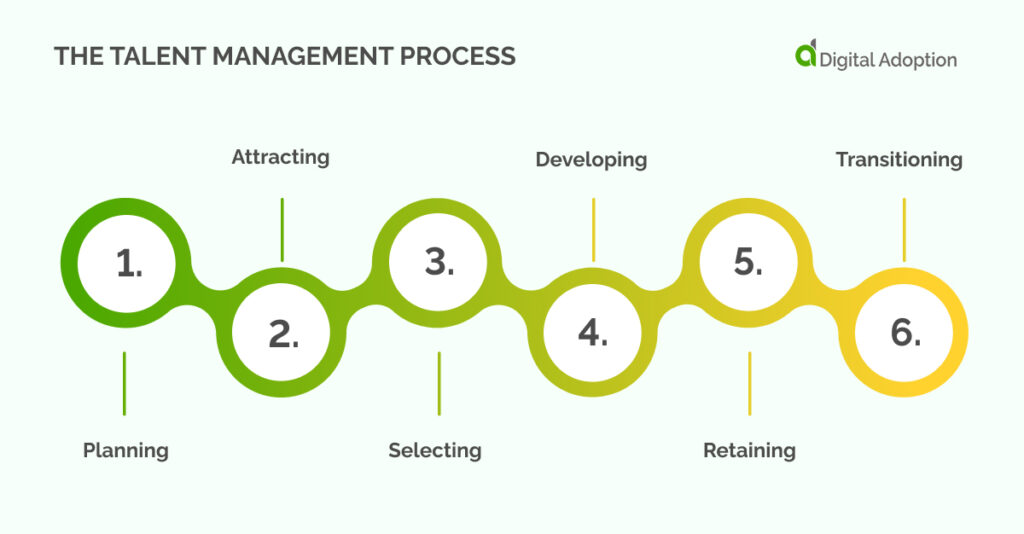The way we perceive the workplace is changing. As the pandemic reshaped the world and introduced new norms of remote working, its effects continue to ripple today. Quiet quitting, driven by remote employee disengagement, is one of these consequences. A record number of employees leaving their jobs after the pandemic, dubbed ‘The Great Resignation’, has been seen too.
It’s for this reason that effective talent management is crucial for HR, now more than ever. Times are changing, but the need for onboarding and retaining talent for your organization has never been more important. Even HR itself has not been immune to this shift, with the industry transitioning to digital platforms over the past decade.
In this guide, we’ll run through the nitty-gritty details of talent management for HR. Here’s how you can implement an effective talent management strategy, and why it’s important for the well-being of employees and overall productivity.
What is talent management?
Talent management is a system designed to cultivate a high-performing workforce. It can address skills gaps, as well as create programs for acquiring, developing, and retaining quality talent.
What is the talent management process?

- Planning
Planning is the foundation of every successful talent management. It’s tempting to jump straight into the action. But the importance of identifying where the gaps lie in your business should not be underestimated. A comprehensive plan ensures that your organization is prepared to attract and integrate new hires effectively.
Start by analyzing your business objectives and current talent pool. Consider collaborating with your employees and stakeholders in this stage, assessing the available resources and capabilities for acquiring new talent. Next, formulate job descriptions for key roles aimed at filling talent gaps in your business.
- Attracting
Once you have a comprehensive plan, it’s time to start attracting potential talent. In this stage, HR should assess whether the talent requirements should be filled from within the organization or from an outside hire.
To acquire talent from sources outside of existing employees, use external channels such as job portals, referrals, and professional networking platforms like LinkedIn. This approach helps ensure optimal results in finding the right candidates that fit your criteria.
It’s best to also identify existing talent pools that can be tapped into, too. Try job boards and social network communities that are tailored specifically to your industry. These places often yield the best talent for your business.
- Selecting
While attracting a diverse pool of talent is crucial, selecting which applicants will work well for your business is equally important. This step involves interviewing to ensure informed hiring decisions.
Effective interviews are often extensive. A string of tests and checks is a must to ensure the ideal person-organization fit. However, the nature of the interviews should be catered to your organization’s needs, as well as time and financial constraints. Examples include written tests and in-depth interviews. Group discussions, logic tests, and psychometric testing are also worth a try.
While you have flexibility in your methods, the goal of a successful selection process is to gather information that provides a comprehensive understanding of the applicant. These steps will lead to effective onboarding, whether in person or remotely.
- Developing

Acquiring talent is a key aspect of a successful talent management process. However, it’s only one piece of the puzzle. Developing the talent you have acquired is an equally important part of the process.
This stage presents its unique challenges, such as maintaining employee engagement and avoiding training overload. Be aware of the “forgetting curve” where recruits tend to forget information within their initial employment period.
An effective onboarding strategy, which focuses on developing new employees, can help negate these challenges. Developing new employees to help them grow within your organization, and training with the expertise needed to contribute to your business’s success, can build loyalty and improve employee engagement.
The bottom line is, you don’t want new recruits to stay in their initial roles. The aim is to help them progress through the company. It’s best to establish a system for ongoing performance, feedback, and development.
Offering regular coaching sessions, extensive training programs, one-on-one mentoring with superiors, counseling, and job-rotation schemes can be a great way to encourage employee development too.
- Retaining
Similar to developing talent, ensure talent is retained within the company too. Retaining talent is a fundamental part of a successful and sustainable business.
Many organizations keep their top talent through promotions and salary increases. Providing opportunities for professional growth and rewards can help keep talent too. Likewise, make sure all members of the workforce are involved in special projects and decision-making processes.
According to Business Insider, high staff turnover is a critical factor employees consider when evaluating if a workplace is “toxic.” Keeping talent makes a good impression on new hires. It also boosts engagement, trust, and satisfaction in your organization.
- Transitioning
An effective talent process doesn’t just focus on onboarding and retaining talent. Instead, it focuses on the collective transitioning of your company as a whole, through the growth of individual employees.
Ensuring effective transitioning can help employees feel part of a bigger whole, even if they’re at the end of their careers. Thus, it’s important to ensure that your talent management process includes retirement benefits and effective exit interviews.
This is an easy step to overlook but should not be missed. Smooth transitions for employees can elevate morale among existing staff, address future recruitment needs, and positively impact your brand reputation.
Examples of talent management process in action
Here are a few practical illustrations showcasing how organizations effectively implement their talent management strategies:
Talent acquisition
First and foremost, effective talent management can help acquire the best talent for your business. For example, you could craft job descriptions to fit your company’s needs. Then, you could post them on the right job boards.
Another strategy could be finding candidates through social media. This includes platforms like LinkedIn or The Dots. It also includes tapping into online talent pools.
Onboarding
While talent acquisition may be the start, onboarding is another crucial element. This stage is often the first impression of your business for new employees, so implementing effective onboarding is crucial.
There are plenty of tools out there for onboarding, make sure to choose the one that’s best for your organization. Other strategies could include onboarding surveys and optimizing these tools for your needs.
Maintaining and developing talent
Retaining talent is another crucial part of the talent management process. Companies use many strategies to keep and grow talent.
They include having regular one-on-one coaching sessions, offering online training, and making development plans. It’s essential to involve employees in this process by tailoring the plans to align with their individual goals within the business.
Succession planning
Succession planning ensures that your business maintains optimum productivity when employees leave the company. It can also be a powerful way to boost morale and engagement with existing employees.
A good succession strategy could involve doing exit interviews. They gauge an employee’s engagement and give insights into talent gaps.
What makes a successful talent management strategy?
Let’s explore the key elements that contribute to creating a robust and effective talent management strategy.
Align talent goals with larger business objectives
An effective talent management strategy is rooted in the overarching business objectives of your organization. However, to achieve these objectives, individual talent goals must be closely aligned with them. That’s why it’s important to align employees’ goals with your wider objectives, and should be implemented throughout every step of your process.
According to Forbes, having clarity on key focus areas and KPS for the short and medium term will enable you to make swifter and better decisions for your business.
Talent and people strategy is a fundamental part of every business goal. It’s best to be intentional about how these goals are aligned with your current workforce.
Communicate the objectives clearly to your employees, and ask them for feedback that you can use to develop your talent management strategy.
Fulfill employee expectations and deliver on hiring promises
It’s a given that any successful business follows through on its commitments, particularly when it comes to its workforce. A successful talent management strategy should place the well-being and motivation of your employees first, but it should also be realistic to avoid disappointment.
Promising a raise or a key role and not fulfilling those promises is a sure way to hurt employee engagement. It harms your business and brand reputation in the long run. That’s why the initial planning stage of your talent management process is key.
Life is unpredictable, especially in the corporate world. However, conducting a comprehensive analysis of your long-term business objectives, costs, profits, and talent acquisition is a crucial component of a successful talent management strategy.
Rely on data and technology to make better workforce decisions
This leads us to another element of talent management strategy: data. When conducting any decision related to talent management, it’s best to make sure it’s based on data, and not the individual. Reliable, accurate, and timely data helps employers. It lets them deliver strategic talent initiatives with confidence.
It’s best to use technology in your talent management strategy, too. There are plenty of options for talent management software to streamline your process. These tools are often data-driven and can assist in sourcing talent, assessing skills and qualifications, onboarding new hires, managing employee strengths, and recognizing and rewarding top performers.
Why is talent management so important for HR?

Talent management is a crucial part of HR. And in many ways, it can make or break a business. After all, a business is only as good as the sum of its parts.
Without a cohesive, and qualified team, the wheels of a workforce simply don’t turn. And, in the worst cases, they can fall off completely. It’s the job of HR to make sure that all cogs of the machine we call a business are oiled, engaged, and working efficiently.
Below are a few reasons why talent management is important for HR:
Increase employee satisfaction, motivation, and retention
Above all, successful talent management can lead to a happy and satisfied workforce. Regular learning and development initiatives improve program management and service delivery. They also boost customer satisfaction. They also create a sense of belonging among employees.
HR-driven talent management strategies aim to motivate employees. They do this through initiatives like promotions and training. These strategies improve employee satisfaction and retention rates. Keeping employees long-term is beneficial, they become more dedicated and skilled with time at the company.
Helps the company remain competitive
A successful talent management process can ensure the company remains competitive too. HR plays a vital role. It ensures there are enough qualified employees to do tasks and meet goals. This enhances operations and supports staff to prevent burnout. This helps keep your company above water. You deliver on goals and stay productive to beat the competition.
Effective talent management is crucial for HR, as it ensures organizations remain in the loop with the latest trends and industry changes.
Not only does an effective hiring process attract top talent, it can be an opportunity to recruit employees in developing areas and fields.
Hiring exceptionally talented individuals across a range of fields, aligned with an organization’s goals, can serve as a competitive edge for the company over its rivals.
Improves client satisfaction
Let’s not forget that talent management is important for HR as it improves client satisfaction too.
Succeeding in talent management gets you top employees. They make the best products or services for clients.
Likewise, retaining employees and keeping turnover to a minimum serves as a good reputation for your brand too, fostering trust with existing and potential clients.
Ensuring Your Talent Management Strategy is Effective and Adaptable
Talent management is a fundamental part of any HR’s role. While it can appear simple on the surface, implementing a successful talent management strategy for your organization requires comprehensive planning, analysis, and critical thinking.
However, the benefits of a successful talent management strategy far outweigh the initial costs. It can not only lead to a happy and engaged workforce but to a more profitable business too.
We’ve given a guide on how HR can implement a successful talent management strategy. But, it’s important to keep up with workplace trends.
The pandemic, for instance, has shifted the world online, with remote working creating its own set of challenges for HR’s talent management strategy. Gen-Z is also bringing new perspectives to the way we perceive the workplace.
Overall, using the points above while maintaining a holistic approach to your organization is key. Ensuring that your strategy is water-tight, from planning to transitioning, will guarantee that your organization effectively attracts, onboards, and retains the best talent for your business needs.













